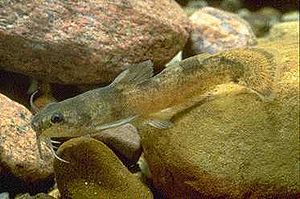Brindled madtom facts for kids
Quick facts for kids Brindled madtom |
|
|---|---|
 |
|
| Conservation status | |
| Scientific classification | |
| Synonyms | |
|
The brindled madtom (Noturus miurus) is a small type of catfish. It belongs to the Ictaluridae family. This fish lives naturally in the eastern parts of the United States.
Contents
What Does the Brindled Madtom Look Like?
Brindled madtoms are small fish. They usually grow to be about 10 to 12.5 centimeters (4 to 5 inches) long.
Like other Noturus species, the brindled madtom has a special fin. This fin is called an adipose fin. It connects from its tail fin almost all the way to its dorsal fin (the fin on its back). The tail fin also wraps around the part of its body before the tail. This area is called the caudal peduncle. It stops just before the anal fin (the fin on its underside).
This fish has smooth skin, not scales. It also has four pairs of barbels, which are like whiskers. These barbels are found near its mouth. The brindled madtom's body is a bit flat from side to side near its tail. But it's flatter from top to bottom near its head.
The brindled madtom is light brown. It has dark spots on its back. It also has two clear dark marks behind its dorsal fin. The dorsal fin itself has a dark spot on its tip. This fin is located between its pectoral fins (side fins) and pelvic fins (bottom fins).
Where Do Brindled Madtoms Live?
Brindled madtoms live in the eastern United States. Their home range is west of the Appalachian Mountains and Blue Ridge Mountains. They are found from the lower Great Lakes area all the way southwest to Louisiana.
You can find them in many river systems, including:
- The Cache River in Illinois
- The Huron River
- The Mississippi River and Ohio River basins
- The Pearl River
- The Wabash River
- The Lake Pontchartrain area, which drains into the Gulf of Mexico
This fish is considered endangered in some states. These include Missouri, Kansas, Pennsylvania, and Michigan. This means there are very few of them left in these areas.
How Brindled Madtoms Live and Eat
Brindled madtoms mostly eat small insects and other tiny creatures. A study from 1982 looked at what they eat. It found that their diet mainly includes:
- Larvae and pupae of flies (like midges and black flies)
- Mayfly larvae
- Caddisfly larvae
- Adult isopods (small crustaceans)
They also eat some worms, other tiny crustaceans, and aquatic insects. They rarely eat fish or plant material.
Bigger fish, like the longnose gar, sometimes eat adult brindled madtoms. The eggs of brindled madtoms are also a food source. Many different animals eat the eggs. These include crustaceans, insects, and other fish.
Most other types of madtoms like to live in fast-moving parts of rivers. But the brindled madtom prefers calmer areas. They like pools that have some siltation (mud or sand settling on the bottom). These pools should also have a lot of texture, like rocks, and gentle currents.
They do best in clean areas at the bottom of swift streams and rivers. These areas should have moderate silt over a rocky or textured bottom. The fish like water temperatures around 25 to 27 degrees Celsius (77 to 81 degrees Fahrenheit). They do not do well in water above 30 degrees Celsius (86 degrees Fahrenheit). If the water gets hotter than 33 degrees Celsius (91 degrees Fahrenheit), many of them can die.
Brindled Madtom Life Cycle
Female brindled madtoms can start having babies when they are one year old. Males are ready when they are two years old. They usually lay eggs from May to July. The exact time depends on the water temperature in their area.
When it's time to reproduce, the male and female fish work together. They guard their eggs, which are called a clutch. A clutch usually has 50 to 100 eggs. They often lay their eggs in a safe spot. This could be under rocks or even inside old bottles or cans found in the water. They choose places with very small openings. The parents also line these shelters with mud or silt.
Brindled madtoms can lay eggs multiple times a year. Most of these fish live for about three years. However, most of the ones found are around two years old.
The brindled madtom is very picky about where it lays its eggs. It needs a specific type of river bottom. This bottom should have a good mix of stones, small rocks, and sediment. This mix provides the shelter and nesting spots they need. Even small changes to their habitat can make it hard for them to reproduce.
The loss of these special habitats has caused problems for many madtom species. This has even led to different types of madtoms breeding together. For example, brindled madtoms have been seen breeding with tadpole madtoms. This might cause changes in their genes over time.
See also
 In Spanish: Noturus miurus para niños
In Spanish: Noturus miurus para niños


